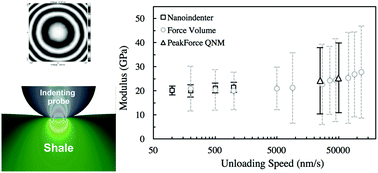Can AFM be used to measure absolute values of Young's modulus of nanocomposite materials down to the nanoscale?†
Abstract
At present, a technique potentially capable of measuring values of Young's modulus at the nanoscale is atomic force microscopy (AFM) working in the indentation mode. However, the question if AFM indentation data can be translated into absolute values of the modulus is not well-studied as yet, in particular, for the most interesting case of stiff nanocomposite materials. Here we investigate this question. A special sample of nanocomposite material, shale rock, was used, which is relatively homogeneous at the multi-micron scale. Two AFM modes, force-volume and PeakForce QNM were used in this study. The nanoindentation technique was used as a control benchmark for the measurement of effective Young's modulus of the shale sample. The indentation rate was carefully controlled. To ensure the self-consistency of the mechanical model used to analyze AFM data, the model was modified to take into account the presence of the surface roughness. We found excellent agreement between the average values of effective Young's modulus calculated within AFM and the nanoindenter benchmark method. At the same time, the softest and hardest areas of the sample were seen only with AFM.



 Please wait while we load your content...
Please wait while we load your content...
